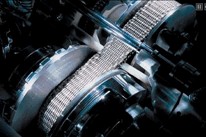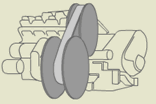| 
Continuously
Variable Transmission (CVT)
 Most
conventional transmission systems control the ratio between engine
speed and wheel speed using a fixed number of metal gears. Most
conventional transmission systems control the ratio between engine
speed and wheel speed using a fixed number of metal gears.
Rather than using gears, the CVTs in currently available vehicles
utilize a pair of variable-diameter pulleys connected by a belt
or chain that can produce an infinite number of engine/wheel speed
ratios.
 This
system has several advantages over conventional transmission designs: This
system has several advantages over conventional transmission designs:
- Seamless acceleration without the jerk or jolt from changing
gears
- No frequent downshifting or "gear hunting" on hills
- Better fuel efficiency
| Efficiency Improvement: |
6% |
| Savings Over Vehicle Lifetime: |
$1,600* |
Additional Information:

Automated
Manual Transmission (AMT)
Automated manual transmissions combine the best features
of manual and automatic transmissions. Manual transmissions are
lighter than conventional automatic transmissions and suffer fewer
energy losses. However, most drivers prefer the convenience of an
automatic.
AMT operates similarly to a manual transmission except
that it does not require clutch actuation or shifting by the driver.
Automatic shifting is controlled electronically (shift-by-wire)
and performed by a hydraulic system or electric motor. In addition,
technologies can be employed to make the shifting process smoother
than conventional manual transmissions.
| Efficiency Improvement: |
7% |
| Savings Over Vehicle Lifetime: |
$1,900* |

* Fuel cost savings are estimated assuming an average vehicle lifetime
of 185,000 miles, a fuel price of $3.07, and an average fuel economy
of 21 MPG. All estimates are rounded to the nearest hundred dollars.
Data Sources
Potential fuel efficiency improvement: Energy and Environmental
Analysis, Inc. 2005. Automotive Technology Cost and Benefit
Estimates. Arlington, Virginia, March.
Average light-duty vehicle fuel economy: Heavenrich, R. M. 2005.
Light-Duty Automotive Technology and Fuel Economy Trends:
1975 Through 2005. Office of Transportation and Air Quality,
U.S. Environmental Protection Agency, Washington, D.C.
Average vehicle lifetime: Calculated based on Transportation
Energy Data Book, Edition 24. Oak Ridge National Laboratory, Oak
Ridge, Tennesse, Tables 3.9 & 8.13.
|